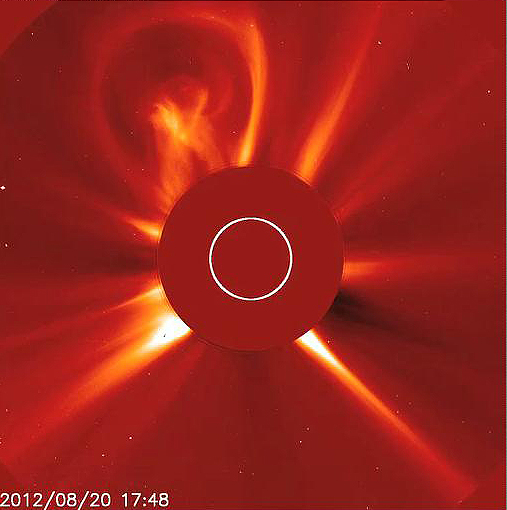Eureka! 'Light Bulb' Solar Storm Erupts from Active Sun

An enormous sun eruption, shaped like a giant glowing light bulb, was captured by a veteran spacecraft that closely monitors our nearest star. NASA scientists dubbed the sun storm a solar "Eureka! moment."
The Solar and Heliospheric Observatory (SOHO) spacecraft, which is a joint mission by NASA and the European Space Agency, snapped the new photos of the bulbous, light bulb-shaped coronal mass ejection as it erupted from the sun's surface on Aug. 20.
Coronal mass ejections (CMEs) are massive clouds of plasma and charged particles that are unleashed into space during strong solar storms. When powerful CMEs are aimed directly at Earth, they can cause geomagnetic and solar radiation storms, which have the potential to disrupt power grids and communications infrastructure on the ground. These solar eruptions can also knock out satellites in space.
The light bulb-shaped CME seen by the SOHO spacecraft has a bright core, surrounded by a very thin, wispy outer edge. It's not uncommon for CMEs to have a rounded shape, but according to NASA officials, it has been years since one took on the appearance of a light bulb.
In the new image, the white circle at the center represents the solar disk, and the photo includes the inner solar corona region up to a staggering 5.25 million miles (8.4 million kilometers) away from the sun, NASA officials said.
SOHO captured photos of the fun-shaped CME on Aug. 20, when a series of eruptions were unleashed from the sun. The spacecraft used its Large Angle and Spectrometric Coronagraph (LASCO) C2 instrument to make the observations.
This instrument is capable of snapping images of the outer layer of the sun, known as the corona, by blocking out the sun's light and creating an artificial eclipse within the instrument, NASA officials explained.
Get the Space.com Newsletter
Breaking space news, the latest updates on rocket launches, skywatching events and more!
SOHO was launched into space in December 1995, and uses 12 different science instruments to stare at the sun. The spacecraft is located roughly 930,000 miles (1.5 million kilometers) away, near a region called the Lagrange Point 1 between Earth and the sun, where gravitational forces combine to create a relatively stable environment.
Follow SPACE.com on Twitter @Spacedotcom. We're also on Facebook and Google+.
Join our Space Forums to keep talking space on the latest missions, night sky and more! And if you have a news tip, correction or comment, let us know at: community@space.com.

Space.com is the premier source of space exploration, innovation and astronomy news, chronicling (and celebrating) humanity's ongoing expansion across the final frontier. Originally founded in 1999, Space.com is, and always has been, the passion of writers and editors who are space fans and also trained journalists. Our current news team consists of Editor-in-Chief Tariq Malik; Editor Hanneke Weitering, Senior Space Writer Mike Wall; Senior Writer Meghan Bartels; Senior Writer Chelsea Gohd, Senior Writer Tereza Pultarova and Staff Writer Alexander Cox, focusing on e-commerce. Senior Producer Steve Spaleta oversees our space videos, with Diana Whitcroft as our Social Media Editor.